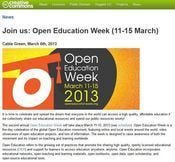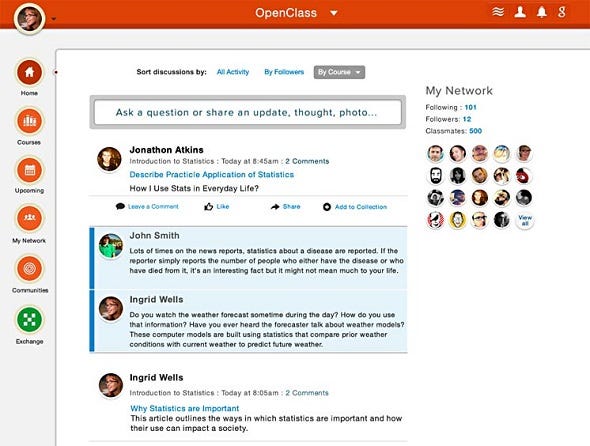Cloud-Based LMS Wins Over Abilene Christian UniversityCloud-Based LMS Wins Over Abilene Christian University
Pearson's cloud-based OpenClass learning management system impressed Abilene Christian University as social, modern, flexible -- and free.


12 Open Educational Resources: From Khan to MIT
12 Open Educational Resources: From Khan to MIT (click image for slideshow)
Abilene Christian University (ACU) is in the process of porting all its online course content from Blackboard to Pearson's OpenClass, which will be its new standard come the fall semester.
OpenClass is a cloud-based learning management system (LMS) that Pearson has offered for free as a way of promoting the adoption of digital content. Pearson is a major publisher of textbooks, software and multimedia for learning, but the OpenClass default course materials catalog loaded into the system is stocked with popular open educational resources, those free textbooks and other course materials that are challenging the traditional publishing business model.
Kevin Roberts, chief planning and information officer at ACU, a 4,600-student university in Abilene, Texas, said he knows full well there's a profit motive hidden in here somewhere. "It would be a huge red flag in my mind if they said they were doing this just because they love education and want to make the world a better place," he said. "They've been very transparent about it. OpenClass is not limited to Pearson content, but they're saying, 'Hey, the Pearson content will work really, really well in here.'"
[ You say you want a revolution? Open Education: Take Back The Curriculum. ]
OpenClass is still advertised as a beta product, and Roberts admitted ACU is being "a little bit" adventurous," but the university was also an early adopter of Google Apps so this is "familiar territory," he said. Some faculty members have already moved to OpenClass, and they have been impressed by the social and mobile features Pearson packed into the latest version, he said. OpenClass is closely integrated with Google Apps and uses Google+ Hangouts for video chat.
"This is a really different approach. First and foremost, this is fully cloud-based and available at no charge to the university. The decision wasn't based solely on price, but that was part of it," Roberts said. At the same time, "Pearson and OpenClass were able to start with 21st century technologies and think, if we were to build an LMS today without being burdened with having to bring on legacy technologies, what would we do?"
The faculty committee that reviewed the software and compared it with the latest offerings from Blackboard and other LMS vendors concluded OpenClass was in a class by itself. "The recommendation of that committee was unanimous," said Mindy Thompson, an adjunct faculty member who was part of that group and now also serves as a director of instructional design, helping the faculty implement the software.
"The opportunity to partner with a company on a new LMS and have them incorporate our feature suggestions was very attractive to us," Thompson said.
Roberts and Thompson made a point of saying that Blackboard had served the university well for many years. However, with the Blackboard contract about to come up for renewal and OpenClass offering an attractive alternative, ACU decided to reexamine its options.
"At that point, we said let's just look everything," Roberts said. "If we want to stay with Blackboard, that's great -- but let's not fall into that decision, let's make that decision."
In the year since ACU made its decision, OpenClass has continued to introduce significant improvements, reinforcing Thompson's belief that it was the right decision. "We liked the open part of OpenClass. I find it very flexible and user friendly. There are several different ways to approach sharing a course, setting up materials and deciding how you want to teach."
For example, Blackboard dictated the course structure to a great extent by a template that is common to all courses, Thompson said. OpenClass makes it easier for instructors to organize a class however they would like. "For example, we're encouraging faculty to think about flipped classroom, which might mean presenting things in a different order. You might start with the exam, using a competency-based model" and then work backwards to fill in gaps in student knowledge, she said. That doesn't mean every course will take a radical approach, "but the ability to consider doing things a different way is something we really liked," she said.
Having social networking built into the platform also allows students to interact with their classmates and professors in a way that feels very natural, without letting those connections cross over into their personal lives, Thompson said. The use of social networking in instructional design shows a lot of promise, with some early research supporting the idea that it aids learning and retention, she said.

OpenClass social dashboard
The OpenClass dashboard welcomes students and faculty with a social activity stream.
The central dashboard a student sees after logging in features a social newsfeed, and there's a feed associated with each course that can act as a "just-in-time study group," Thompson said. Instructors can also host online office hours in the feed.
Some courses had been taking advantage of closed Facebook groups for such purposes, but doing so tended to raise awkward questions. Students thought it was weird if a professor asked to become their Facebook friend or felt self-conscious having their instructor as part of the audience for their everyday posts, Thompson said. "At the same time, some professors would say, 'I don't want to be friends with my students on Facebook -- they're my students.' This helps with some of those boundary issues." OpenClass generated a mix of excitement and skepticism when it was first announced in October 2011 at an EDUCAUSE event. Many of the skeptics were looking for the catch, suspicious that free did not really mean free.
Yet it really is a free platform that "anyone in the world can use any way they like," said Scot Chadwick, VP and general manager of OpenClass for Pearson. The service is already being used by more than 6,000 institutions and nonprofits, as well as more than 100 companies for various learning needs. Although OpenClass was designed for higher education, it is also starting to see adoption at the K-12 level, he said. The beta label doesn't seem to be a big obstacle to adoption, Chadwick said, but OpenClass should exit beta this summer.
The cloud software itself will not be "freemium" in the model of Yammer, a social software product that provides a basic version of its cloud service for free but reserves more advanced administrative features for paying customers. However, Pearson does expect to sell some supporting services, such as help desk and tutoring, and, of course, Pearson content, Chadwick said. Even there, Pearson has shown a light touch, initially stocking the Learning Exchange marketplace built into OpenClass entirely with open educational resource (OER) content.
"We wanted to reinforce that it's not about Pearson content in particular," Chadwick said. "That was a question when we launched -- is this just some trick for Pearson to force us into buying Pearson content. Obviously, those were questions people needed to ask." Instead, Pearson is aiming for something more like the iTunes model, where Apple makes it really easy to buy from the iTunes Store but it's still possible to download content from elsewhere and manage it with the iTunes software, he said.
If Pearson were to limit OpenClass to institutions willing to commit exclusively to Pearson content "we'd be reducing the universe of potential users by quite a lot," Chadwick said. Instead, the OpenClass user interface is designed to wrap around any Web-based content an instructor might want to use. For example, it's easy to choose a TED talk video and embed it in a course.
Immersive, multimedia experiences can also take over most of the screen, rather than being confined to a small frame. Through an application programming interface, third-party applications can also hook into the OpenClass commenting system, making it possible to annotate and comment on objects in a 3-D virtual world. As an example, he had a colleague demonstrate science courseware created by Arizona State University in the Habitable Worlds environment.
Pearson also has commercial offerings in the LMS and online learning categories, including Pearson Learning Studio, a product of its eCollege division.
Pearson is aiming to introduce its own disruptive innovation in the market, undercutting those products before someone else does. With OpenClass, the company is betting that the base technology for delivering and organizing educational content will be less important than the content itself. "Historically, this has been owned and managed by the IT department and considered an IT decision in a lot of ways," Chadwick said. "We think the technology decision is going to be there, but there will be more decisions at the institutional level about the content and what they're delivering to students."
In particular, Pearson sees greater potential in "highly produced" educational experiences that incorporate video, animation and gamification techniques, he said.
Follow David F. Carr at @davidfcarr or Google+, along with @IWKEducation.
About the Author
You May Also Like






